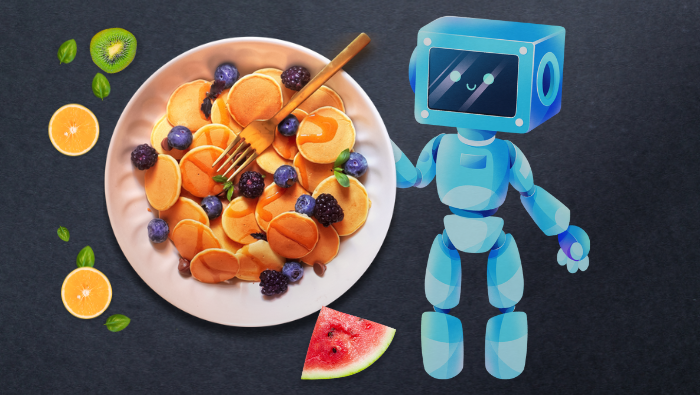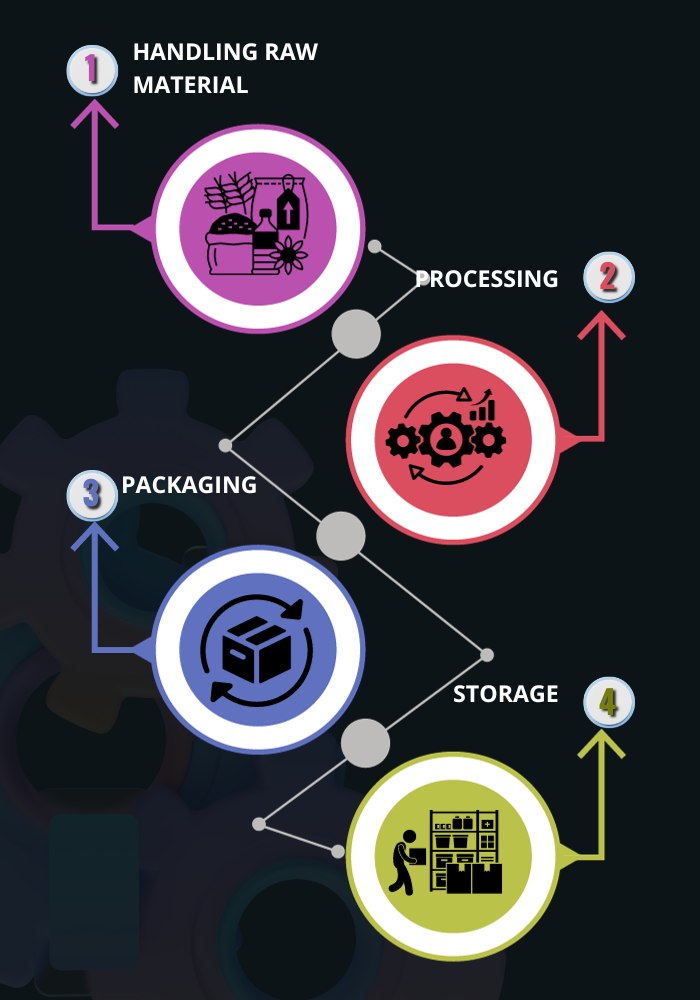The food industry is one segment of the economic world that, at first glance, appears to not benefit from innovation. Understandably so, as people associate food with chefs, the hands of the creators, and not with a machine. However, that is far from the reality. If the food industry was primarily made up of just cooking, it might be true, but today, it is one industry that does the most in terms of not just production but also distribution. These two segments will benefit from AI solutions.
Therefore, it comes as no surprise that food automation is happening in full swing. The fact is that while we produce sufficient food to feed everyone in the world, the place where we struggle the most is distribution. While there are companies that are throwing away food, people in several countries are malnutritional, suffering from a variety of diseases, and do not have all their dietary needs met.
Now, the food industry is also integrating AI into the system to revolutionize not just the production but also the distribution and consumption of food.
Today, AI technologies, including machine learning services, are being used not just for improving supply chain logistics, enhancing food safety standards, and improving agricultural practices.
Benefits of Introducing AI Solutions into the Food Industry
Before dwelling on the various ways in which the food industry benefits from robotics and artificial intelligence, let us take some time to understand why they are opting to do so; every change comes with its own set of benefits and disadvantages.
So, here is a quick look at the various benefits of using AI solutions in the food industry.
It helps keep your workforce safe
Automation allows for improved safety as robots can take over dangerous tasks across the production line. For example, today, machines are doing a lot of the heavy lifting, allowing people to focus on more business-critical tasks.
Additionally, it will limit the need for safety gear required at work, saving people more money.
Consistency becomes the norm
When machines are working on any project, they are more consistent with work. With automation, you can expect consistent quality of work. When it comes to food, people prefer packaged food because they know what taste to expect. When it comes to raw food, the taste can change significantly between bites. Think of fruit salad, where some pieces of apple are sweet, and others are sour.
With automation in the production line, you can create products that taste consistent. And giving people what they want is what keeps food companies in business.
Improved End-to-End traceability
When it comes to tracing raw materials and food, nothing beats AI. It is the tool that will allow businesses to keep track of all things being used. Additionally, it can help improve the supply chain, delivery process, as well as production.
The use of automation also ensures that your company complies with all relevant regulations.
Higher Productivity
Machines do not need rest, do not get tired, and are very reliable as employees. This is why companies that opt to integrate robotics and artificial intelligence to achieve food automation reap better results.
When things are streamlined using automation, things do not get delayed. Your employees are free from the tedious work, enabling them to take care of the other important aspects of the business.

Reducing food waste with Improved Supply and Demand Management
One aspect of AI solutions, automation, and robotics that is truly encouraging companies to make the shift is the fact that it helps reduce waste. Companies want to avoid waste as it means loss of money and extra work for no extra pay.
With AI, you can reduce the overall food waste while improving management on both the supply and demand sides.
Ingredients Control
Food companies are under scrutiny by the public for ethically sourced ingredients. Food automation is a must for companies that want to follow ethical practices.
Additionally, these systems can help identify any issues in the ingredients, making response faster and more effective.
Targeting Better
There are several ways in which businesses can benefit from automation. And one aspect of it is targeting a better audience. AI in visual search is changing the game. Augmented reality in several major food platforms is allowing users to experience the food before ordering, encouraging them to make the order now.
Moreover, the role of AI in improving customer experience cannot be neglected. With the right tools, you can ensure a positive experience for most, if not all, of your clients.
Improved Scalability
Automation also allows for more flexibility in operations. From creating ways to sustain ample growth in times of energy crisis to changing production line productivity to better meet the required demand, everything is possible with the right AI solutions.
All these benefits make it abundantly clear why the food processing automation market size is expected to reach US$ 33.93 by 2029.
As stated before, all things have their own set of advantages and disadvantages, and food automation is no different.
Disadvantages of Integrating AI Solutions in Food Automation
So, here we are briefly touching on some cons that you must be aware of at the beginning.
- The initial cost of integrating AI is not something every company can afford. It not only includes the hardware and software but also encompasses staff training.
- Initially, it can cause job displacement as specific tasks get automated.
- There is a maintenance cost that you will need to shell out from time to time to ensure appropriate results.
- While it is possible to automate the kitchens, it causes a loss of culinary artistry, and that can have a negative impact on your business.
- Customers might also find new methods harder to accept. Steps must be taken to ensure that they become comfortable with the new technology.
Also, data security and other technical issues come into play when you rely on technology.
However, given the fact that businesses must stay competitive and offer the best services, AI solutions for food automation are more than a luxury. It is a need without which businesses will soon become irrelevant.
AI Solutions – Transforming the Food Industry as We Know It
If you took the time to read the above, it is clear that automation has a lot of benefits, though there are a few curveballs that we must address during integration. However, it is a necessary element, primarily because the growing population has a lot more demands that need fulfilling. AI ML services have already made their place in the food industry. Rest assured, these technologies are playing a big role in almost all parts of the food industry.
So, if you want to learn what exactly these technologies are doing, keep reading.
Agriculture Segment of the Food Industry
Let’s start with the raw material. Agriculture is what brings food to life. With AI and robotics, they are finding ways to make production more sustainable while being efficient. Saving water with accurate irrigation using water is only one example of how AI is helping make the most of every resource.
AI ML services also have a role to play in identifying diseases and can perform the tasks of planting, harvesting, and weeding with accuracy.
Food Automation in Manufacturing

The manufacturing process consists of four segments:
- Handling Raw Material
- Processing
- Packaging
- Storage
And automation can assist with them all.
With robotics combined with artificial intelligence, it is possible to make machines, sensors, and control systems work on the tedious work.
Additionally, they can be used for sorting and grading the products.
Packaging is one aspect of manufacturing that can benefit significantly from robotics. From weighting to filling and sealing packages, everything can be automated. It helps reduce human error while ensuring everything is appropriately labeled, sealed, and coded.
All this culminated in creating a system that is thorough and ensures proper storage of the products.
Food Automation in Cooking
Automated machines of today can slice, dice, and portion ingredients with unparalleled precision. All of this helps reduce labor while improving the quality control of products.
Moreover, there are tools capable of cooking ready-to-eat meals. They have the setting to ensure proper temperature and appropriate time for meal prep.
Furthermore, stirring and mixing through the new machines and technologies is possible as well.
Food Delivery & Supply Chain
The food industry and logistics have always gone hand in hand. The fact is that while we produce enough food, we do not have enough resources to make it reach everyone who needs it. AI is helping tackle the issue by trying to create better systems. From ensuring that the food reaches the right place to make sure that it finds its way to your doorstep, AI has a role to play.
In the near future, we will likely also experience fully automated delivery through drones, and if that isn’t cool, I don’t know what is. A McKinsey & Company report predicts that by 2030, drones could deliver up to 30% of all online orders.
When it comes to the supply chain, AI solutions also predict the next requirements based on previous data, getting accurate results. So, there is no shortage of raw materials at the production unit.
Of course, there are several other ways in which AI can assist the food industry. It can lend a hand in every aspect of food company. However, if you are looking for a particular solution using the latest AI software development tools, then you must get in touch with the experts.
Food Automation – AI Solutions Making Food More Accessible
In a nutshell, the need for food automation is abundantly clear. Its benefits far outweigh the challenges. Furthermore, the diverse ways in which it can assist businesses with improving their overall skill set make it the ultimate choice for people who want to stand out in the industry.
At MoogleLabs, we take a keen interest in the overall capabilities of artificial intelligence. From understanding generative AI services trends that are redefining 2024 to the more practical uses of the technology, we are doing it all. So, whatever your need or query, we are ready to help.
Fill out the form with details of your queries, and we will gladly sit with you to create appropriate solutions for you.